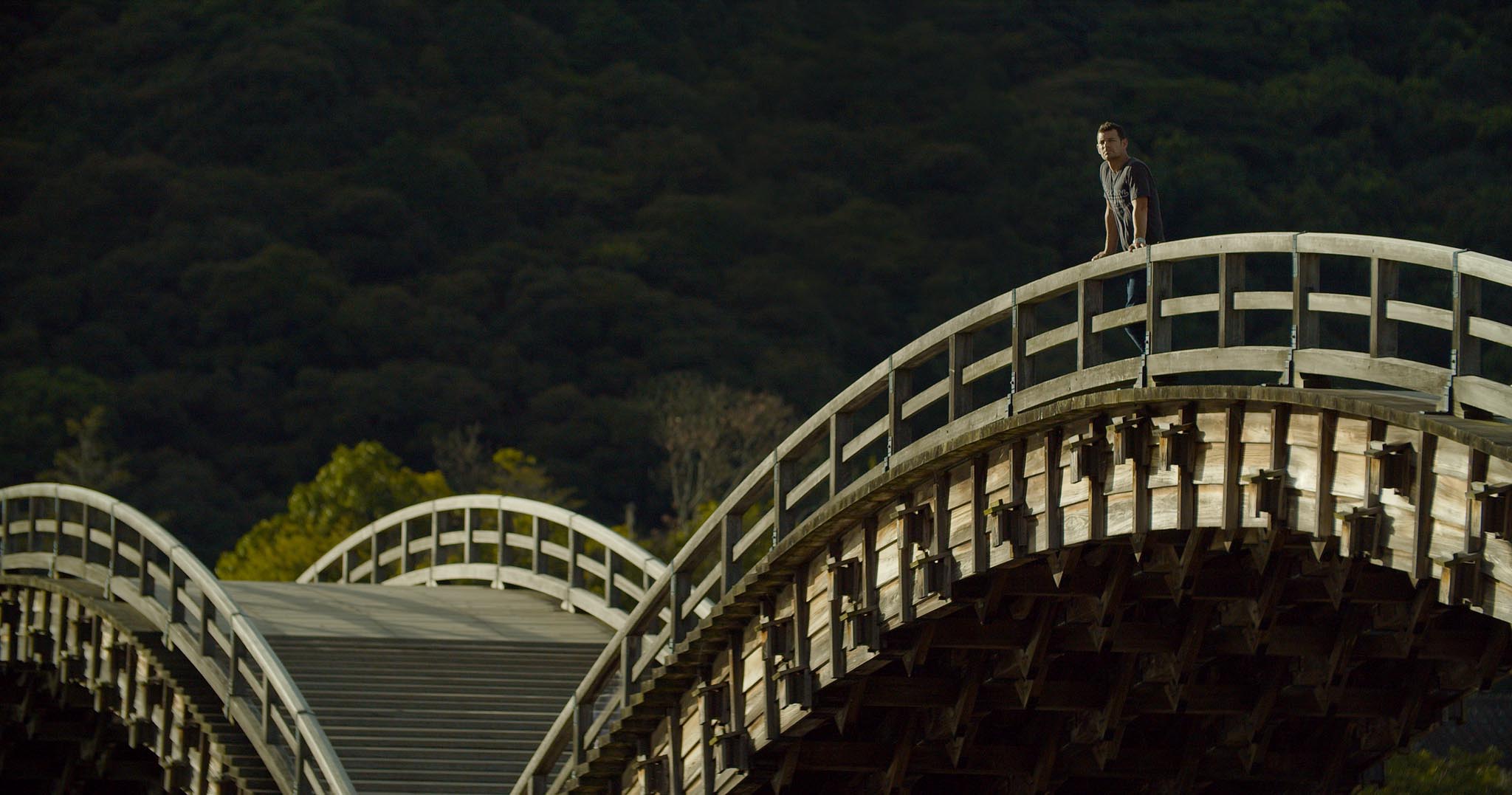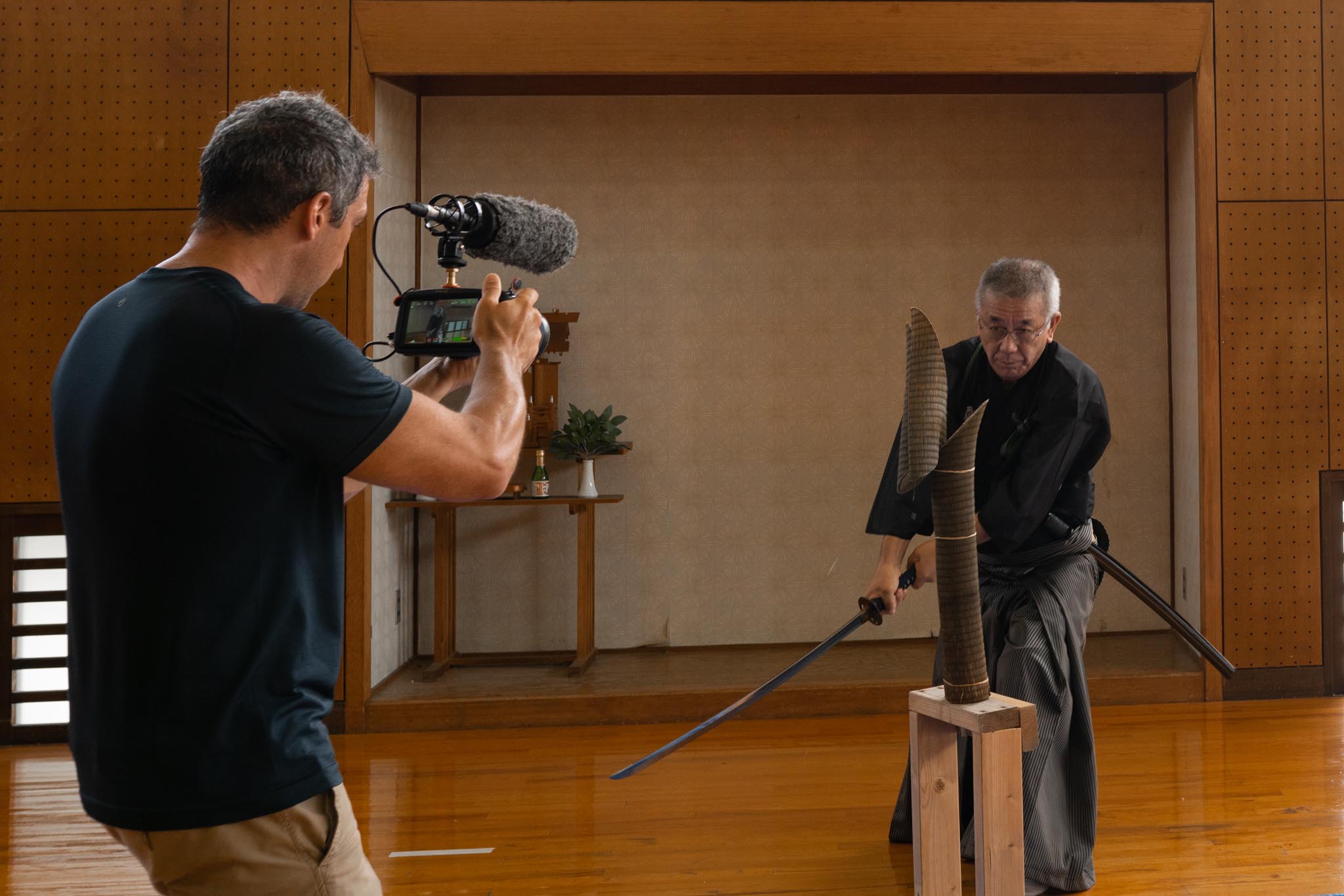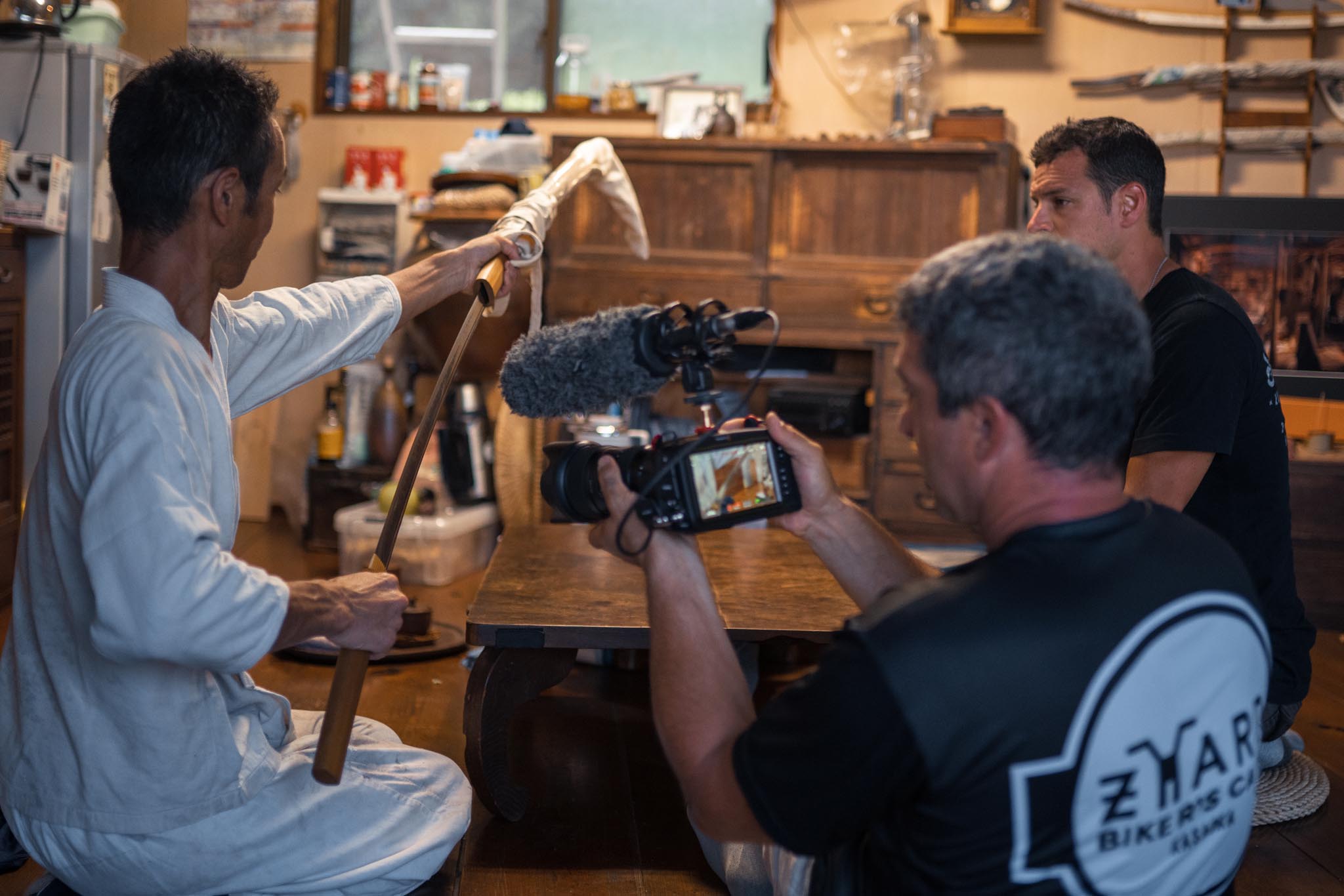Jon Fauer: Please tell us about your company and the origins of Into The Rising Sun.
Scott Wilson: Andre Dupuis and I started Echo Bay Media, a full-service film production company, 20 years ago. Our focus was mainly on travel documentary TV production. We worked in more than 80 countries and all seven continents following our passion for travel and telling those stories. We created over 70 hours of TV documentaries shown on Netflix, Amazon Prime, National Geographic, Discovery Channel and many more worldwide. We pride ourselves on taking these projects from inception through post-production and delivery, all in-house.
In all that travel, we had the pleasure of going to Japan many times. So when we were approached by a Japanese TV network called TSS, based in Hiroshima, to co-produce a mini-series about travel in Japan, we jumped at the opportunity. They were looking for an English-speaking TV-documentary with a production company that had the ability to help them create the series for a western audience. They had seen our work and felt we were a good fit.
Tell us about your camera package.
Andre Dupuis: We had Blackmagic Design Pocket Cinema Camera 6K, Pocket Cinema Camera 4K and the URSA Mini Pro 4.6K G2. The Blackmagic Design URSA Mini Pro 4.6K G2 was our main “A” Camera. The built-in ND filters of the URSA Mini Pro G2 made life really easy—especially in a documentary where, as you know, you’re outside following content one second and then the story has you being pulled inside. Spinning a dial to change the ND lets me stay in the flow of content. I hate stopping a developing story just to change filters. I like the URSA Mini Pro G2 because it has 15 stops of dynamic range. The Pocket Cinema Cameras have 13 stops of latitude.
Despite having 15 stops of Dynamic Range, the URSA Mini Pro G2 does not have dual ISO like the Pocket Cinema 4K and 6K. Especially when using the Pocket Cinema Camera 4K with our Metabones Speedbooster, it is amazing in low light.
I’ve been quite happy with the images I’m getting with 13 stops of dynamic range from the Pocket Cinema Cameras given the benefits of having such small and light (and inexpensive) camera bodies. Their 13 stops of latitude make them acceptable as “A” cameras for National Geographic and Discovery Channel broadcast standards. As HDR becomes more adopted, I would love to see a future Pocket Cinema Camera 6K with 15+ stops of latitude. (And maybe internal NDs :)
Because the URSA Mini Pro G2 is more like an ENG-style camera, it can sometimes be a bit large for the quick run and gun adventure filming we often find ourselves in. So we would then switch to the Blackmagic Pocket Cinema Cameras. We had both the 4K and the 6K models. The 4K was in a cage powered by a V-mount battery, which was crazy. I don’t think we even used a quarter of the battery’s power for an entire day of shooting. The Pocket Cinema Camera was also our “B” camera for cross-shooting interviews and grabbing cutaways. Often it was fitted with a Canon 70-200 f/2.8 lens.
The Pocket Cinema Camera 6K has a Super35 sensor. The 4K has a Micro Four-Thirds sensor, so we had a Metabones Speed Booster which makes that camera a low light beast. Along with our SIGMA 35mm f1.4, and the low noise at 3200 ISO, we could nearly see in the dark.
The Pocket Cinema Camera 6K was also our dedicated gimbal camera on a DJI Ronin-S. I’ve operated Steadicam for years, so I’m used to the delicate art of Steadicam-ninja-stepping. Nevertheless, with a Gimbal there’s always a little bit of image sway because of the lack of a stabilized Z-Axis. So, the extra resolution of the Pocket Cinema Camera 6K was helpful because we could remove any sway digitally in post-stabilization. We had the resolution to post-stabilize and still get a sharp 4K image.
What lenses were you using?
Andre: We had a kit of EF-mount lenses—mainly the SIGMA Art series. They were fitted with 3D printed gears to use with our Ronin-S gimbal and follow focus. The SIGMA 18-35 ART f/1.8 was our main lens on the URSA Mini Pro G2. It’s a nice wide zoom that was great for covering most of the on-camera spoken content.
The rest of our kit was comprised of the SIGMA ART 24-35 f/2 Art Lens on the Ronin-S. We had a number of SIGMA ART primes: 35 mm, 50mm, and 85mm f/1.4 DG HSM Art lenses. We also had a ZEISS 135mm f/2 Apo Sonnar T* ZE . They color match quite well and have similar bokeh. Canon lenses made up the rest of our kit: EF 100mm f/2.8 Macro L IS, EF 70-200mm f/2.8 L USM and my favorite, the EF 11-24mm f/4 L USM. We had to do a little bit to color match the Canon glass to the rest of the kit in DaVinci Resolve Studio.
All lenses were in EF mount?
Andre: Yes, they all are. I’m a big fan of the SIGMA Art series because of their technical quality. They’re not weather sealed like the SIGMA Full Frame High Speed Cine lenses, but they’re high performing glass for the money. In our other productions, over the years we’ve written off about three because of dust and moisture. But, you get so much value in terms of the image quality compared to the cost. We haven’t gotten to the point yet where we have to spend four times the money to get a lens that might be a little bit more robust for the kind of shooting that we do. I’ve been quite happy with them.
Scott, are you the on-camera person?
Scott: Being a partner and producer with the company, I can’t ever escape being heavily involved behind the camera, but for a number of our successful series I have also ended up in front of the lens as well.
We’re usually a pretty lean team which allows us to be quite agile and mobile for a lot of the work that we do. A big crew not only can be costly with all the travel, but also, for the kind of story we’re trying to tell, can get cumbersome. And so, there’s often a need from the very beginning for us to wear a few different hats from time to time.
How big a crew did you have on this job?
Scott: We had a crew of six from Canada: Jeff Wilson, Producer; Keiichi Kubo, Exec. Coordinating Producer; Scott Wilson (me) as Host/Producer, Andre Dupuis, DP and Camera Operator; Ryan Edwardson, Second Camera Operator/1st AC; Kristin Thorogood, PA/BTS camera.
The Japanese team consisted of Toshihiro Mori and Takeshita Takami, Producers from TSS; and Taro Yagi, Director at TSS.
Did you have have a Focus Puller?
Andre: The kind of travel-adventure shows we produce often have very small crews of no more than 5 people who combine jobs. I’m both Director and DP. I love working with big crews and having all the collective creative brain power and the tools.
But on these shows, that size of crew strangles the authenticity of the scene and everything ends up feeling scripted and stiff. We have a crew of 5, a production van and whatever we can carry on our backs. Part of the reason why I love the Blackmagic Pocket Cinema Cameras so much is that I get to have incredible image quality and still fit a number of great lenses and a drone in my backpack.
Then how do you manage focus?
Andre: I started in ENG-style production, so I’m just used to pulling my own focus. It gets tricky with a gimbal move while simultaneously following focus. Sometimes I ask for another take or two. One issue we found with the Blackmagic Pocket Cinema Cameras is that without the added weight of the Cage and V-Mount battery, we would have to be very delicate pulling focus as the torque would easily translate into the shot. The cameras are so light that the slightest touch can show up as shake in the shot. Most of the time I am pulling focus directly on the lens myself. On the Ronin-S we have DJI’s follow focus which is incredibly smooth and responsive.
Scott: After more than 60 hours of hosting TV documentaries with Andre shooting, you really learn a necessary rhythm to anticipate the needs of the camera. We’re very aware of each other and how to work together for the best shots. If I need to slow up just for a second before I switch from sun to shade to give him a moment to close down, then I can.
What is Into The Rising Sun about?
Scott: Into The Rising Sun is a four-part half hour mini-series. I am the foreign traveler exploring some of the lesser-seen parts of Japan by motorcycle. I’ve done quite a lot of travel by motorcycle and I find that it’s a great way to explore a country because, for better or for worse, you’re immersed in the environment. So, if it’s cold, you feel cold. If it’s raining, you get wet. I think there’s something about that heightened sense of awareness of where you’re going and where you are.
And so for me, hosting and being truly a part of the environment that I’m exploring is a great way to experience it. The sights, the smells, going through the countryside on a motorcycle all add to the experience. Best of all, it’s often a conversation stimulator even beyond language. You stop for a snack or to get gas and even through a language barrier someone will come up and want to know about the bike and who you are, where you are going.
For this show, I was riding a 2020 Kawasaki Z900RS. It’s a great modern bike that reflects on Kawasaki’s heritage with classic retro styling. This is a theme we touch upon in the series: Japan as a wonderful meld of old and new.
How did you do running shots of the motorcycle?
Andre: We had a production van and shot from it using the Ronin-S stabilizing the Pocket Cinema Camera. Scott has a Bluetooth headset in his motorcycle helmet so we could communicate directly with him from the van. We also had a few drones: the Inspire 1 and the Mavic Pro 2. Takeshita Takami, Producer for TSS Japan, did an incredible job assisting us with Drone clearance. He was able to clear almost anywhere we wanted to shoot in a matter of minutes. Normally Scott handles this and it can take weeks or even months to get permission to film specific locations on a specific day at a specific time. We were very lucky to have Takami-san.
Where were the locations?
Scott: The series covers mostly south-central Honshu from Shimonoseki to Okayama, and then on to Shikoku as well. The scenery and riding there was mind-blowing.
Who does the editing and the grading?
Scott: The editing was done by Jordan Krug and Cameron Hucker at Suede Productions, in Windsor. We’ve had the pleasure of using their talent a number of times for our past projects. All the color grading and online was done in-house at Echo Bay Media with DaVinci Resolve Studio. Finishing in DaVinci Resolve Studio is such a dream now. When shooting on Blackmagic cameras in Blackmagic RAW, the workflow is the way it was meant to be.
Andre: I don’t know if DaVinci Resolve Studio has made me a better or worse DP because now I often know what I can get away with in color. There have been times in the past where I would never shoot at some of the ISOs that we do today. I now have more confidence in knowing how much noise I can eliminate by using DaVinci Resolve Studio with the press of a button. I know I shouldn’t say “Fix it in post” but DaVinci Resolve Studio is magic, and sometimes in the documentary world you just have to make do with the light you are given.
That lets you be more daring. What formats were you shooting in and how did you handle the data on location?
Andre: We shot everything in Blackmagic RAW 8:1. Now that we have gone through the whole process with Blackmagic RAW from acquisition to finish, in some situations 8:1 was not good enough. With shots that had a lot of foliage or highlights sparkling on the ocean at sunset, the codec started to have macro-blocking. We cleaned it up in DaVinci Resolve Studio using temporal noise reduction but for more recent productions we have now been shooting Blackmagic RAW 5:1.
The DJI Inspire footage was shot in RAW using CinemaDNG RAW. Our Mavic 2 Pro was shooting in DJI D-Log H.265 4K.
For Data Management we had a Pelican 1510 case with all our hard drives and media card readers. We copy everything over to multiple backups using HEDGE DMT software on a MacBook Pro. We had three levels of backup: two spinning 7200 RPM drives and one SSD Raid. The SSD Raid consists of multiple Samsung EVO 2TB SSDs arranged in a Raid 5. The whole four-part series was just shy of 12 Terabytes of data.
How was this production funded and what were the shoot dates?
Scott: It was funded by TSS and the Japanese Government. We shot from September 1 to 17, 2019.
In summary?
Andre: The new Pocket Cinema Cameras power on quickly. They are lightweight. A single V-mount battery powers it for more than a day. All the support gear can be smaller, lighter and more manageable for the most demanding types of remote documentary production. As Scott and I plan out our next series, these Blackmagic Pocket Cinema Cameras will be with us again.
This article first appeared in FDTimes April 2020 Issue 101.















